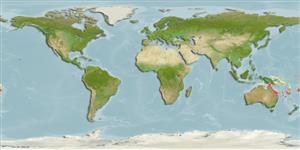>
Blenniiformes (Blennies) >
Tripterygiidae (Triplefin blennies) > Tripterygiinae
Etymology: Norfolkia: Named for the Norfolk Island ( In 1953 Henry W. Fowler named this new genus on a Collection of Fishes Made by Dr. Marshall Laird at Norfolk Island) (R.Bajol, pers.comm. 04/2016)..
More on authors: McCulloch & Waite.
Environment: milieu / climate zone / depth range / distribution range
Ecologie
marien rifbewoner; diepte 0 - 12 m (Ref. 13227). Subtropical
Southwest Pacific: Australia, including Lord Howe Island, Norfolk Island, Middleton Reef, and Elizabeth Reef; and New Caledonia.
Grootte / Gewicht / Leeftijd
Maturity: Lm ? range ? - ? cm
Max length : 6.6 cm SL mannelijk / geslacht onbekend; (Ref. 54980)
Dorsale stekels (totaal): 18 - 19; Dorsale zachte stralen (totaal): 10-11; Anale stekels 2; Anale zachte stralen: 20 - 21. Head to eye and preopercle with scales; small and palmate supraorbital tentacle; light gray or light brown body with 2 linear series of uneven brown blotches with larger dorsal series and some upper blotches joining with lower; below eye is an oblique, dark brown bar with white margin; remainder of head dark brown, blending to white ventrally; females with oblique dark bands on second and third dorsal fins, darkening as they cross rays; uneven, vertical dark bars on caudal fin; yellow or orange dorsal and caudal fins in males. Dorsal rays IV + XIV-XV (typically XV) + 10-11 (typically 11); lateral line discontinuous, 21-24 + 14-19; mandibular pores 5-6 + 1 + 5-6 (Ref. 54980).
Adults are found in intertidal pools in coral reef areas (Ref. 13227). Eggs are hemispherical and covered with numerous sticky threads that anchor them in the algae on the nesting sites (Ref. 240). Larvae are planktonic which occur primarily in shallow, nearshore waters (Ref. 94114).
Levenscyclus en paargedrag
Maturiteit | Voortplanting | Paaien | Eieren | Fecunditeit | Larven
Fricke, R., 1994. Tripterygiid fishes of Australia, New Zealand and the southwest Pacific Ocean (Teleostei). Theses Zool. 24:1-585. (Ref. 13227)
Status op de Rode Lijst van het IUCN (Ref. 130435)
Gevaar voor de mens
Harmless
Gebruik door de mens
Visserij: van geen belang
Meer informatie
Lokale namenSynoniemenMetabolismePredatorenEcotoxicologieVoortplantingMaturiteitPaaienPaaiaggregatiesFecunditeitEierenOntwikkeling van de eieren
ReferentiesAquacultuurAquacultuurprofielKweeklijnenGeneticaElectrophoresesErfelijkheidZiektesVerwerkingNutrientsMassaconversie
Tools
Speciale rapporten
Download XML
Internetbronnen
Estimates based on models
Preferred temperature (Ref.
123201): 23.2 - 27.9, mean 26.4 °C (based on 383 cells).
Fylogenetische diversiteitsindex (Ref.
82804): PD
50 = 0.5625 [Uniqueness, from 0.5 = low to 2.0 = high].
Bayesian length-weight: a=0.00562 (0.00258 - 0.01228), b=3.08 (2.89 - 3.27), in cm total length, based on LWR estimates for this (Sub)family-body shape (Ref.
93245).
Trofisch niveau (Ref.
69278): 3.2 ±0.4 se; based on size and trophs of closest relatives
Weerstandsvermogen (Ref.
120179): Hoog, minimale populatieverdubbelingstijd minder dan 15 maanden (Preliminary K or Fecundity.).
Fishing Vulnerability (Ref.
59153): Low vulnerability (10 of 100).
Nutrients (Ref.
124155): Calcium = 167 [66, 399] mg/100g; Iron = 1.29 [0.60, 2.61] mg/100g; Protein = 19.1 [17.8, 20.4] %; Omega3 = 0.147 [0.060, 0.365] g/100g; Selenium = 15.4 [4.9, 42.6] μg/100g; VitaminA = 47.7 [11.0, 220.5] μg/100g; Zinc = 2 [1, 3] mg/100g (wet weight);
